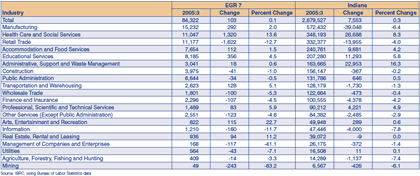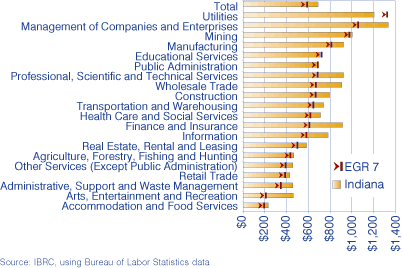Regional Perspective: Economic Growth Region 7
Economic Growth Region (EGR) 7, located in the west-central portion of the state, shares a border with Indiana's western neighbor Illinois.
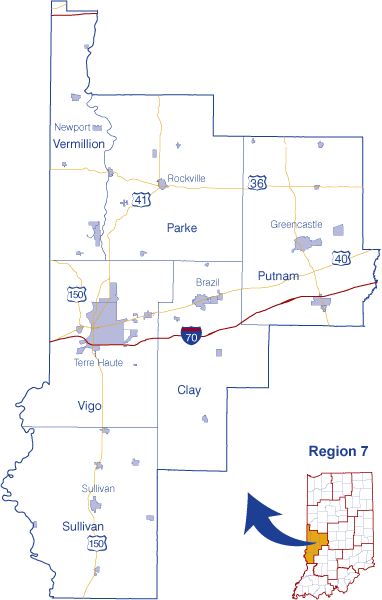
It has fewer people calling it home than any of the 11 regions in Indiana with a 2005 population of about 222,400 people (equivalent to 3.5 percent of the state's population). The region consists of six counties: Clay, Parke, Putnam, Sullivan, Vermillion and Vigo. Vigo County makes up more than 46 percent of the region's population (see Figure 1). However, Vigo County's share of the population has been declining since 2000 and it had 3,100 fewer people in 2005 than it did at the turn of the century (see Figure 2). The other five counties in the region have seen at least some population growth over that time span, though it wasn't enough to make up for Vigo County's losses, with the region overall seeing losses of about 1,800 people.
Figure 1: Population Distribution, EGR 7
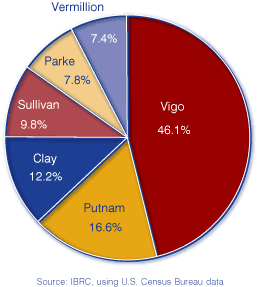
Figure 2: Change in Population in EGR 7 Counties, 2000 to 2005
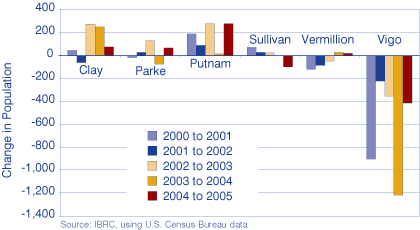
Where is everyone going? Over that same five-year span, the region added about 850 people naturally (more births than deaths), meaning that the loss in population cannot be attributed to a natural decrease. Net migration was ‑2,359 since 2000, meaning more people moved out of the region than into it.
Jobs
In the third quarter of 2005, there were 4,361 establishments in EGR 7 supplying 84,322 jobs. The industry providing the most jobs at both the state and regional level was—to no surprise—manufacturing. However, EGR 7 contributed only 18.1 percent of its workers to the manufacturing industry compared to 19.9 percent at the state level. The change in manufacturing jobs from 2001:3 to 2005:3 moved in opposite directions at the state and regional levels. The number of jobs supplied by the manufacturing industry at the state level during that time decreased by 6.4 percent; Region 7, on the other hand, added 292 jobs in the manufacturing industry over the four-year period for a 2 percent increase.
One of the largest manufacturers in the region is Columbia House, which manufactures music and movies, employs between 1,000 and 5,000 workers, and brings in between $500 million to $1 billion in sales each year. Table 1 shows the nine largest manufacturing employers in the region in terms of number of people employed, five of which are located in Vigo County. Eli Lilly is the largest manufacturing contributor to the region's economy outside of Vigo County, bringing in more than $1 billion in sales each year; it doesn't, however, employ as many workers as Columbia House.
Table 1: Largest Manufacturing Employers in EGR 7
From 2001:3 to 2005:3, the mining industry in EGR 7 saw the most dramatic percent change in jobs, dropping 83.2 percent. In 2001, the industry made up 0.3 percent of all jobs in the region; this figure fell to 0.1 percent in 2005. Numerically, the mining industry in Region 7 lost 243 jobs, making up 57 percent of the mining industry losses for the entire state. The retail trade industry saw the largest numeric decline in jobs and was the only industry in EGR 7 to lose more jobs than the mining industry (see Table 2).
Table 2: Change in Jobs in EGR 7 and Indiana, 2001:3 to 2005:3
Wages
Economic Growth Region 7 has increased average weekly wages across all industry sectors by $92; at the state level, average weekly wages increased by $95, making it appear as though EGR 7 is barely trailing the state. However, a closer look reveals that EGR 7 still pays, on average, $94 less per week than the state (compared to a $91 difference in the same direction in 2001).
The biggest difference between state and regional average weekly wages was in the finance and insurance industry, with Indiana paying about $298 more per week than the region (see Figure 3). This is worse than in 2001, when the state was averaging $281 more than Region 7. There were three industries that the region paid more than the state: utilities, education services and public administration. Utilities showed the biggest difference between EGR 7 and the state, paying $125 more per week in EGR 7. This is quite an improvement over the past four years: at the same time in 2001, the state exceeded EGR 7s pay by $29.
Figure 3: Average Weekly Wages in EGR 7 and Indiana, 2005:3
Commuting
Of the approximately 91,100 people who work in EGR 7, 93.2 percent also live in the region. Figure 4 shows the commuting patterns for Region 7. At the local level, Vigo County unsurprisingly received the most workers from fellow EGR counties, with more than 9,500 people coming in from other parts of the region to work. Next in line was Putnam County with almost 1,900 workers coming from elsewhere within the region.
Meanwhile, Clay County contributed the highest number of workers to the other five counties in the region, sending out over 4,800 workers. Putnam County was the only county that did not provide workers to every other county in the region. Even when it did send out workers to other regional counties, it wasn't sending an equal share. Five of the six counties sent out at least 2,400 workers to other parts of the region; compare that to the 306 people sent out by Putnam County.
Figure 4: EGR 7 Commuting Patterns, 2000
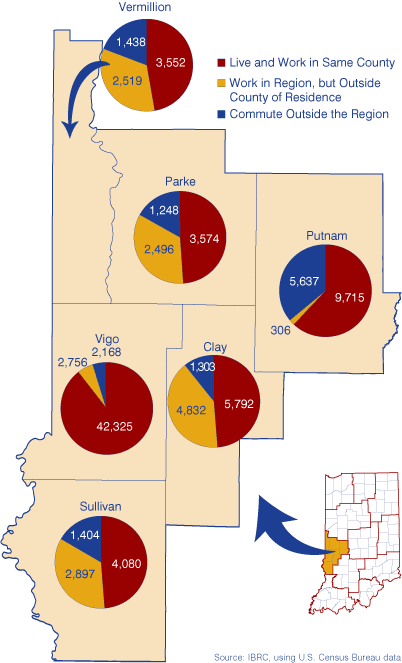
Molly Marlatt, Research Associate
Indiana Business Research
Center, Kelley School of Business, Indiana University


